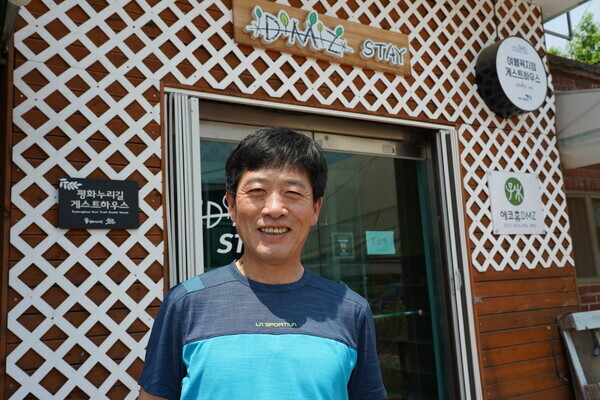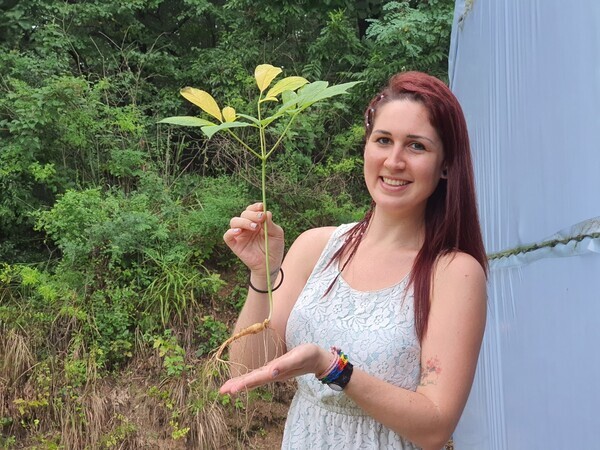hankyoreh
Links to other country sites 다른 나라 사이트 링크
S. Korean travel entrepreneur meshes DMZ, ginseng to attract young tourists

Yoon Seol-hyeon, 54, left his job in Seoul four years ago and opened the DMZ Stay guesthouse in the Majeong No. 1 village of Munsan, a town located in front of Imjingak in Paju, Gyeonggi Province. His goal is to remind his guests of the fact that Korea was one before it was divided.
“I want to help the younger generations recognize the similarities between South and North through the Demilitarized Zone (DMZ) Kaesong ginseng experience, and to see and experience the DMZ with a new sense and perspective.”
Explaining his reasons for developing a tourism experience around Kaesong ginseng, he said, “As a shared asset of South and North, Kaesong ginseng has been the original ‘Korean Wave’ for a millennium.”
“Ginseng doesn’t distinguish between South and North,” he added.
Yoon’s first attempt at a DMZ tourism effort centering on Kaesong ginseng was selected early this month by the city as a “Paju themed commercial renewal project.”
It gained further momentum when it was chosen for a 2021 Ministry of SMEs and Startups project for supporting “local creators,” with the theme “DMZ Kaesong ginseng stay: a new realm of dark tourism.” This secured the necessary funding for remodeling the “experience cafe” and managing the program in its early stages.

Starting July, Yoon plans to launch a full-scale DMZ tourism experience focusing on ginseng, which he will be linking to his guesthouse and a ginseng farm within the Civilian Control Zone (CCZ). Participants in the tour will have an opportunity to harvest their own ginseng and to make processed foods, desserts, and mini flower pots with it.
Four years ago, Yoon left his job in Seoul for the countryside, opening DMZ Stay and working as an eco-guide for the Imjin River Eco Road and Pyeonghwa Nuri Trail. The idea for his latest project came to him after a conversation with tourists he met at the guesthouse.
“I was talking to a Japanese tourist who had been to both the South and North Korean sides of Panmunjom, and they said that the guides gave different explanations,” he said.
“For instance, in the North they talked about the ‘poplar tree incident,’ while in the South they call it the ‘Panmunjom ax murder incident.’ I felt that the DMZ shouldn’t be a place where the conflicting South and North Korean perspectives on Panmunjom should be forced on foreign tourists too.”

As he considered ways of recovering the things shared by South and North, Yoon was eating fried ginseng with another tourist at the Paju Kaesong Ginseng Festival at Imjingak. It occurred to him that “ginseng tastes the same whether you’re eating it here or in Kaesong.” He realized that the Kaesong ginseng of the DMZ was a historical resource — a way of sharing the understanding that South and North Korea have been, are, and will remain one country.
Later on, he showed a DMZ ginseng field to foreign tourists and explained about it. The tourists wondered why it was called “Kaesong ginseng,” and marveled at the sight of the roots in the ground. “Amazing,” they said.
There was certainly a base around the DMZ in Paju, with 153 hectares of ginseng fields grown by 243 farms in the former Jangdan County area alone.
The city of Paju currently operates a DMZ tour that visits the Third Tunnel, Dora Observatory, and villages around the CCZ. It’s used by 600,000 people per year, but Yoon always felt that it was little more than a three-hour sightseeing course — and that new content was needed to keep tourists around.
“I’ve always wondered why we send tourists home after three hours. I found it unfortunate that the DMZ tour amounts to a photograph stamp,” he said.
“For the sake of true ‘peace tourism,’ I thought the DMZ ginseng experience was perfect as content for sharing how [South and North Korea] have always been one, rather than emphasizing their division and differences.”
Yoon also shared his hopes that ginseng tourism will help to revitalize the local economy, creating work for ginseng farmers and local residents.
“Over the past six years, it’s gotten harder and harder for ginseng farmers to find land. With experience-based tourism, they can create a more diverse profit structure,” he said.
“Ginseng farming itself is a national asset on par with intangible cultural heritage. We can’t just let it disappear.”
Borrowing the home of a friend who had closed their restaurant, Yoon opened Paju’s only DMZ guesthouse, with a 12-guest capacity. But the process has not been easy.
Shortly after he opened it, the inter-Korean summits sparked a torrent of calls looking for bookings.
But with the souring of inter-Korean relations, an Africa swine fever outbreak, and the COVID-19 pandemic, the number of guests plummeted. To make matters worse, the Gyeonggi Tourism Organization set up 40 caravan units accommodating four to six people each in the nearby Imjingak campsite.
“They do a preliminary survey even for a small supermarket in a neighborhood commercial area, yet here they had what amounted to a few good-sized motels’ worth of caravans coming in without a single word. I protested to Gyeonggi Province and the city of Paju that this was a variety of hospitality business, but there was nothing I could do about it,” he said.
“I think what’s allowed us to withstand the shock is the fact that we’re just a small-scale guesthouse.”
He said, “Travelers walking the Pyeonghwa Nuri Trail have had problems with the lack of accommodations, but they haven’t really popped up around here because they aren’t seen as economically viable.”
“To achieve sustainable tourism, we need to get away from the model centering on attracting tourists primarily through Imjingak. Instead, we should have a lot of small-scale tourism actors,” he said.
“Both the DMZ and [Kaesong] ginseng are things you only find in Korea. If we combine the two, we can make Korea’s strongest tourism package in terms of global name recognition,” he noted.
He added that his dream is to “work with local residents to create the first inter-Korean brand based on Kaesong ginseng, like the world-famous Sunkist beverage brand.”
“I hope to see it becoming a world-renowned model of experience-based tourism, like the chateau winery tours in France.”
By Park Kyung-man, North Gyeonggi correspondent
Please direct comments or questions to [english@hani.co.kr]

Editorial・opinion
![[Column] Life on our Trisolaris [Column] Life on our Trisolaris](https://flexible.img.hani.co.kr/flexible/normal/500/300/imgdb/original/2024/0505/4817148682278544.jpg) [Column] Life on our Trisolaris
[Column] Life on our Trisolaris![[Editorial] Penalties for airing allegations against Korea’s first lady endanger free press [Editorial] Penalties for airing allegations against Korea’s first lady endanger free press](https://flexible.img.hani.co.kr/flexible/normal/500/300/imgdb/original/2024/0502/1817146398095106.jpg) [Editorial] Penalties for airing allegations against Korea’s first lady endanger free press
[Editorial] Penalties for airing allegations against Korea’s first lady endanger free press- [Editorial] Yoon must halt procurement of SM-3 interceptor missiles
- [Guest essay] Maybe Korea’s rapid population decline is an opportunity, not a crisis
- [Column] Can Yoon steer diplomacy with Russia, China back on track?
- [Column] Season 2 of special prosecutor probe may be coming to Korea soon
- [Column] Park Geun-hye déjà vu in Yoon Suk-yeol
- [Editorial] New weight of N. Korea’s nuclear threats makes dialogue all the more urgent
- [Guest essay] The real reason Korea’s new right wants to dub Rhee a founding father
- [Column] ‘Choson’: Is it time we start referring to N. Korea in its own terms?
Most viewed articles
- 1New sex-ed guidelines forbid teaching about homosexuality
- 2OECD upgrades Korea’s growth forecast from 2.2% to 2.6%
- 3[Column] Life on our Trisolaris
- 460% of young Koreans see no need to have kids after marriage
- 5Months and months of overdue wages are pushing migrant workers in Korea into debt
- 6Inside the law for a special counsel probe over a Korean Marine’s death
- 7Korean government’s compromise plan for medical reform swiftly rejected by doctors
- 8[Guest essay] Maybe Korea’s rapid population decline is an opportunity, not a crisis
- 9Trump asks why US would defend Korea, hints at hiking Seoul’s defense cost burden
- 10Two lung cancer deaths at Samsung Electronics deemed occupational in nature